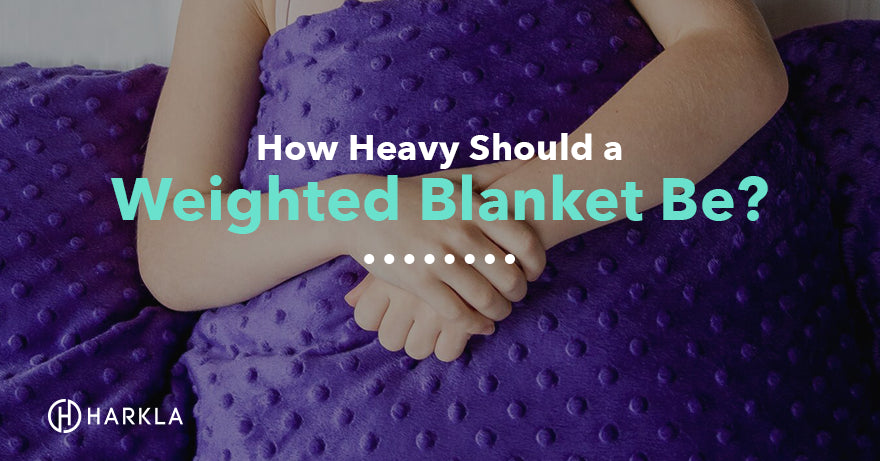Your Cart is Empty

Weighted blankets are similar to weighted vests in that they offer deep touch pressure (DTP) to the body. Since we know that proprioceptive, deep touch pressure helps to release serotonin, a neurotransmitter that helps to regulate some brain functions, weighted blankets are used to help with sensory modulation and regulation.

These sensory-based interventions that have a DTP component have been shown to have a calming, organizing effect on one’s nervous system. For more information on Deep Touch Pressure, read more here.
If you’re wondering how heavy should a weighted blanket be, it depends on who will be using it - a child, a teenager, and an adult will all use weighted blankets of different weights in order to attain the most benefits.
A general guideline when deciding on how heavy your blanket should be is to multiply the user’s body weight by 10% and add 1-2 lbs. depending on preference. For example, a 50-lb child would be given a 5-lb. weighted blanket on the low end and a 7-lb. blanket on the high end.
For a 200-lb adult, the weight of the blanket could be 20-22 lbs depending on preference.
Here is a simple weighted blanket weight chart that may be helpful if figuring out how heavy should a weighted blanket be,

This simple weighted blanket for kids chart and adult guide helps you match the right size and weight to each user.

Keep in mind that you want the weight to be heavy enough to provide deep touch pressure, but not so heavy that it poses a safety risk during sleep. Infants, babies, and some toddlers should not use weighted blankets because they lack the motor skills and strength to maneuver a weighted blanket off them should the need arise.
The type of weight and style of the blanket will differ on how the weight is distributed, and the design may impact washability, so take a close look at how the blanket is weighted. For more information on washing your weighted blanket, check out our article here.
Harkla’s weighted blankets come with a 100% money-back guarantee. It’s no wonder that they’ve become best-sellers for children and adults alike!
If a weighted blanket is too heavy, it can cause discomfort instead of relaxation.
You might notice:
It’s hard to change sleeping positions.
You feel hot or restricted under the blanket.
You wake up sore or uncomfortable.
A blanket that’s too heavy may also increase body temperature or cause interrupted sleep. The goal is gentle, calming pressure, not feeling trapped. If you experience any of these signs, try a lighter blanket within your range.
You can tell you’ve chosen the right blanket weight if it feels relaxing and natural on your body. Signs your blanket is the right fit:
You fall asleep more easily or feel calmer at rest.
You can move and breathe comfortably.
You don’t feel overheated or sore.
If you find yourself pushing the blanket off during sleep, it’s likely too heavy. If you barely feel pressure or don’t notice a difference, go slightly heavier next time.
A weighted blanket should be about 10% of your body weight, plus 1-2 pounds. For example, if you weigh 150 pounds, your weighted blanket should weigh 15-17 pounds. This weight provides enough deep touch pressure to feel calming without being too heavy or uncomfortable.
A 130 lb person can use a 20 lb weighted blanket, but it may feel too heavy for most people. The recommended weight for someone who weighs 130 pounds is 13-15 pounds. A 20 lb blanket is about 15% of their body weight, which might make it harder to move or feel too restrictive during sleep. If you're comfortable and sleep well with it, it can work, but starting lighter is usually better.
Yes, a 50 lb weighted blanket is too much for almost everyone. Most adults weigh between 100-250 pounds, which means their ideal blanket weight should be 10-25 pounds. A 50 lb blanket would only be appropriate for someone weighing 500 pounds. Using a blanket this heavy can make it hard to breathe, move, or get out from under it safely. It poses a serious safety risk.
The 10 percent rule means your weighted blanket should weigh roughly 10% of your body weight. You can add 1-2 pounds based on personal preference. This rule helps you find a weight that provides calming deep pressure without being uncomfortable or unsafe. For example, a 200 lb adult would use a 20-22 lb blanket, while a 50 lb child would use a 5-7 lb blanket.
It's better to start lighter if you're unsure. A blanket that's too light won't cause harm, it just won't provide much benefit. A blanket that's too heavy can cause discomfort, make it hard to move, increase body temperature, and disrupt your sleep. You can always go heavier later if a lighter blanket doesn't feel like enough pressure. Comfort and safety should always come first.
Comments will be approved before showing up.

